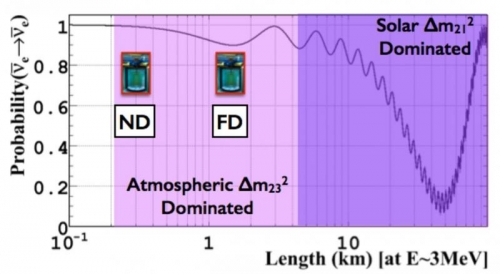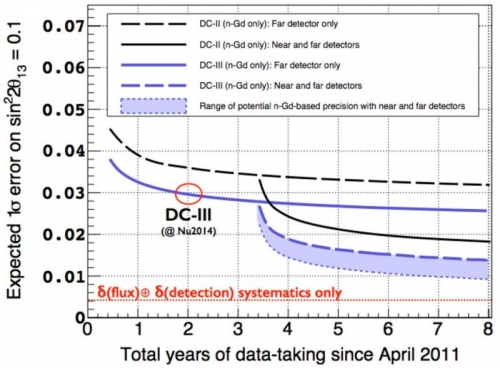
The Double Chooz (DC) experiment (based France) is based on an international collaboration from institutions from Brasil, Europe, Japan, Russia and US.
 DC is a reactor neutrino experiment conceived for high precision measurement of the leptonic mixing matrix angle θ13. Anti-νe‘s are detected via the robust Inverse Beta Decay (IBD) interaction providing a high signal to background and control of systematics using rather small (~10 tons target) detectors nearby the EdF Chooz nuclear reactor plant (Chooz, France). DC, like all the reactor-θ13 experiments following its concept, consists of two detectors for major reduction of correlated systematics upon inter-detector comparison. With the multi-detector configuration, the remaining systematics errors are of the order of a few per mille. The far detector (FD) started data taking back in spring 2011, while the near detector (ND) starts by october 2014. Therefore, DC has run with only the FD for ~3 years (systematic budget handicapped by the dominating ~1.7% flux uncertainty) and it is expected to run with both FD+ND for ~3 more years to achieve nominal exposure and sensitivity (see figure on the right). The rationale of the experiment is illustrated by this figure, where the θ13 driven flux disappearance (~10% effect) is expected at the FD, ~1km away from reactors, to be compared with the ND, ~400m away from reactors. The oscillation phase is driven by the so-called “atmospheric” Δm2.
DC is a reactor neutrino experiment conceived for high precision measurement of the leptonic mixing matrix angle θ13. Anti-νe‘s are detected via the robust Inverse Beta Decay (IBD) interaction providing a high signal to background and control of systematics using rather small (~10 tons target) detectors nearby the EdF Chooz nuclear reactor plant (Chooz, France). DC, like all the reactor-θ13 experiments following its concept, consists of two detectors for major reduction of correlated systematics upon inter-detector comparison. With the multi-detector configuration, the remaining systematics errors are of the order of a few per mille. The far detector (FD) started data taking back in spring 2011, while the near detector (ND) starts by october 2014. Therefore, DC has run with only the FD for ~3 years (systematic budget handicapped by the dominating ~1.7% flux uncertainty) and it is expected to run with both FD+ND for ~3 more years to achieve nominal exposure and sensitivity (see figure on the right). The rationale of the experiment is illustrated by this figure, where the θ13 driven flux disappearance (~10% effect) is expected at the FD, ~1km away from reactors, to be compared with the ND, ~400m away from reactors. The oscillation phase is driven by the so-called “atmospheric” Δm2.
DC has gone through 3 data-releases so far (several publications) with the corresponding analyses upgrades, reducing each time uncertainties well beyond statistics sensitivity. Critical dates:
•First DC-FD data. June 2010 @ Athens, Greece by Anatael Cabrera (IN2P3,FR) [talk]
•DC-Gd-I [ref]. Nov. 2011 @ Seoul, South Korea by Hervé de Kerret (IN2P3, FR) [talk]
•DC-Gd-II [ref,ref]. June 2012 @ Kyoto, Japan by Masaki Ishitsuka (Tokyo Tech. Inst., JP)
•DC-Gd-III [ref]. May 2014 @ Paris, France by Anatael Cabrera (IN2P3, FR) [talk,advert]
The most important achievement of DC, so far, relies on the excellent control of systematics, thanks to the high quality of the detector performance, allowing unprecedented handles for background reduction, excellent response control and the corresponding data analyses developed, yielding a remarkable ~1.8% total systematic uncertainty for a single-detector run phase, still not competitive in the global θ13 scenario. However, now with the ND being online, the systematics cancellation is largest due to the effective iso-flux configuration of the DC site, thus yielding a virtual total cancellation of flux systematics. This is illustrated in the figure (right) and will be soon the new reality of DC.
DC’s 1σ error will go from ~0.03 (DC-III today), up to ~0.01 (projected from FD-only performance). However, it should be noted that the DC-III analysis is so good, in terms of systematics, that the overall experiment is limited by the statistics sensitivity for about 10 years (irreducible systematics at ~0.005), if using only Gd-n IBDs, due the high performance of the analysis/reconstruction/detector system. This implies that other techniques can be exploited to improve the overall sensitivity of DC beyond 0.01 — an ongoing collaboration effort in fact.
@APC, we have led much of the experiment (effective head-quarter) in many critical fronts: many large mechanical piece of the detector, electronics (FADC system, co-developed with CAEN electronics, Italy), DAQ, much of the IBD analyses (including selection and leading background contributions), as well as leading energy reconstruction strategy and several coordination operation (spokes-person, detector operations, energy reconstruction, systematics and electronics/online/DAQ, etc).
List of APC staff involve (in alphabetical order)
T. Akiri, W. Bertoli, A. Cabrera, B. Courty, J.V. Dawson, V. Durand, L. Fernando-Gonzalez, D. Franco, P. Gislain, A. Givaudan, H. Gomez, P. Guillouët, A. Hourlier, M. Karakac, H. de Kerret, D. Kryn , A. Lafitte, T. Lasserre, M. Obolensky, A. Onillon, A. Remoto, R. Roncin, B. Silva, F. Suekane, K. Terao, A. Tonazzo, D. Vincent, S. Wagner, S. Vydelingum

